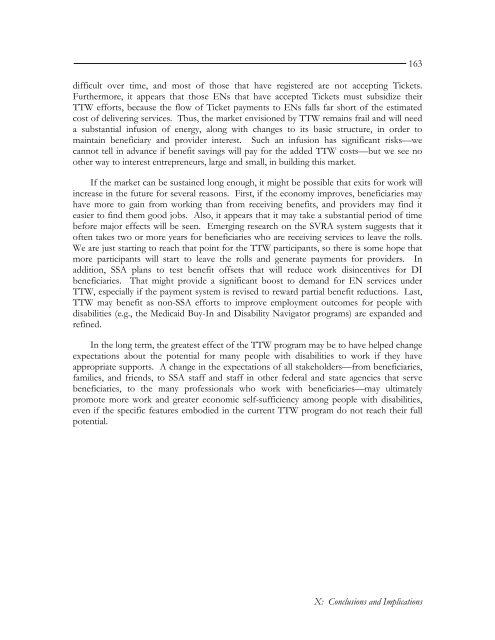Evaluation of the Ticket to Work Program, Implementation ...
Evaluation of the Ticket to Work Program, Implementation ...
Evaluation of the Ticket to Work Program, Implementation ...
You also want an ePaper? Increase the reach of your titles
YUMPU automatically turns print PDFs into web optimized ePapers that Google loves.
difficult over time, and most <strong>of</strong> those that have registered are not accepting <strong>Ticket</strong>s.Fur<strong>the</strong>rmore, it appears that those ENs that have accepted <strong>Ticket</strong>s must subsidize <strong>the</strong>irTTW efforts, because <strong>the</strong> flow <strong>of</strong> <strong>Ticket</strong> payments <strong>to</strong> ENs falls far short <strong>of</strong> <strong>the</strong> estimatedcost <strong>of</strong> delivering services. Thus, <strong>the</strong> market envisioned by TTW remains frail and will needa substantial infusion <strong>of</strong> energy, along with changes <strong>to</strong> its basic structure, in order <strong>to</strong>maintain beneficiary and provider interest. Such an infusion has significant risks—wecannot tell in advance if benefit savings will pay for <strong>the</strong> added TTW costs—but we see noo<strong>the</strong>r way <strong>to</strong> interest entrepreneurs, large and small, in building this market.If <strong>the</strong> market can be sustained long enough, it might be possible that exits for work willincrease in <strong>the</strong> future for several reasons. First, if <strong>the</strong> economy improves, beneficiaries mayhave more <strong>to</strong> gain from working than from receiving benefits, and providers may find iteasier <strong>to</strong> find <strong>the</strong>m good jobs. Also, it appears that it may take a substantial period <strong>of</strong> timebefore major effects will be seen. Emerging research on <strong>the</strong> SVRA system suggests that it<strong>of</strong>ten takes two or more years for beneficiaries who are receiving services <strong>to</strong> leave <strong>the</strong> rolls.We are just starting <strong>to</strong> reach that point for <strong>the</strong> TTW participants, so <strong>the</strong>re is some hope thatmore participants will start <strong>to</strong> leave <strong>the</strong> rolls and generate payments for providers. Inaddition, SSA plans <strong>to</strong> test benefit <strong>of</strong>fsets that will reduce work disincentives for DIbeneficiaries. That might provide a significant boost <strong>to</strong> demand for EN services underTTW, especially if <strong>the</strong> payment system is revised <strong>to</strong> reward partial benefit reductions. Last,TTW may benefit as non-SSA efforts <strong>to</strong> improve employment outcomes for people withdisabilities (e.g., <strong>the</strong> Medicaid Buy-In and Disability Naviga<strong>to</strong>r programs) are expanded andrefined.In <strong>the</strong> long term, <strong>the</strong> greatest effect <strong>of</strong> <strong>the</strong> TTW program may be <strong>to</strong> have helped changeexpectations about <strong>the</strong> potential for many people with disabilities <strong>to</strong> work if <strong>the</strong>y haveappropriate supports. A change in <strong>the</strong> expectations <strong>of</strong> all stakeholders—from beneficiaries,families, and friends, <strong>to</strong> SSA staff and staff in o<strong>the</strong>r federal and state agencies that servebeneficiaries, <strong>to</strong> <strong>the</strong> many pr<strong>of</strong>essionals who work with beneficiaries—may ultimatelypromote more work and greater economic self-sufficiency among people with disabilities,even if <strong>the</strong> specific features embodied in <strong>the</strong> current TTW program do not reach <strong>the</strong>ir fullpotential.163X: Conclusions and Implications
















